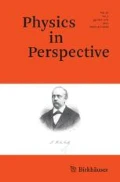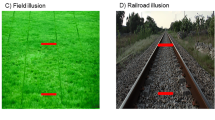Abstract
I trace the attempts to determine the Earth-Sun distance, which is based on measurements of the solar parallax, from the naked-eye observations of Aristarchus of Samos in antiquity to observations of the transits of Venus in the 18th century, noting the nature of the observational errors involved in them. I then turn to measurements of stellar positions with meridian or transit telescopes in the 17th to 19th centuries using the eye and ear method of observation. I show how an analysis of the observational discrepancies in this method led to the discovery of an observer’s “personal equation,” and ultimately to the birth of experimental psychology.










Similar content being viewed by others
References
John Locke, An Essay Concerning Human Understanding, collated and annotated, with prolegomena, biographical, critical, and historical by Alexander Campbell Fraser. Vol. 1 (New York: Dover Publications, 1959), p. 25.
René Descartes, Discourse on the Method [1637], in Descartes Philosophical Writings, A selection translated and edited by Elizabeth Anscombe and Peter Thomas Geach (Indianapolis and New York: The Bobbs-Merrill Company, 1971), pp. 5–57, on p. 11.
Idem, Meditations on First Philosophy [1692], First Meditation, ibid., pp. 59–65, on p. 62.
Steven Shapin, The Scientific Revolution (Chicago and London: The University of Chicago Press, 1996), p. 13.
Ernest Nagel, Principles of the Theory of Probability [International Encyclopedia of Unified Science, Volume 1, Number 6] (Chicago: The University of Chicago Press, 1939), pp. 2–3.
William H. Stahl, “Aristarchus of Samos,” in Charles Coulston Gillispie, ed., Dictionary of Scientific Biography. Vol. I (New York: Charles Scribner’s Sons, 1970), pp. 246–250, on pp. 248–249.
Edm. Halleio, “Methodus Singularis Qua Solis Parallaxis Sive Distantia a Terra, ope Veneris intra Solem Conspiciendoe, Tuto Determinari Poterit,” The Philosophical Transactions of the Royal Society of London, 29 (1716), 454–464; translated as Dr. [Edmond] Halley, “A new Method of determining the Parallax of the Sun, or his Distance from the Earth.” ibid. Abridged 6 (1809), 243-219, on 244.
Flamsteed to Henry Oldenburg, November 10, 1672, quoted in David Sellers, In Search of William Gascoigne: Seventeenth Century Astronomer (New York, Heidelberg, Dordrecht, London: Springer, 2012), p. 28.
Ibid., p. 30.
Halley, “new Method” (ref. 7), p. 244.
Ibid., pp. 244–245.
Agnes M. Clerke, A Popular History of Astronomy during the Nineteenth Century, Fourth Edition, Revised and Corrected (London: Adam and Charles Black, 1902), p. 229.
Isaac Newton, Opticks, 4th ed. (London: Printed for W. Innys, 1730; reprinted New York: Dover, 1952), Book. 1, Part. 1, Proposition 8, Problem 2, p. 110.
Christiaan Huygens, Cosmotheoros, sive de Terris Coelestibus, earumque orrnatu, conjecturae (The Hague, 1698), translated as The Celestial Worlds Discover’d: or, Conjectures Concerning the Inhabitants, Plants and Productions of the Worlds in the Planets (London: Printed for Timothy Childe, 1698), p. 110.
Bradley E. Schaefer, “The Transit of Venus and the Notorious Black Drop Effect,” Journal for the History of Astronomy 32 (2001), 325–336, on 325.
Ibid., pp. 326–328.
Jay M. Pasachoff and William Sheehan, “Lomonosov, the Discovery of Venus’s Atmosphere, and Eighteenth-Century Transits of Venus,” Journal of Astronomical History and Heritage 15, No. 1 (2012), 3-14.
The Journals of Captain Cook, Prepared from the original manuscripts by J.C. Beaglehole for the Hakluyt Society, 1955–67. Selected and edited by Philip Edwards (London: Penguin Books, 1999), p. 55.
Sir Richard Woolley, “Captain Cook and the Transit of Venus of 1769,” Notes and Records of the Royal Society of London 24, No. 1 (June 1969), 19–32, esp. 29.
Jimena Canales, A Tenth of a Second: A History (Chicago and London: The University of Chicago Press, 2009), p. 14. Canales (note 27) points out that the term “quantifying spirit” is the “driving spirit” of Tore Frängsmyr, J.L. Heilborn, and Robin E. Rider, ed., The Quantifying Spirit in the 18th Century (Berkeley, Los Angeles, Oxford: University of California Press, 1990).
Canales, Tenth of a Second (ref. 20), p. 14.
Quoted in Phillipe de la Cortadière and Patrick Fuentes, Camille Flammarion (Paris: Flammarion, 1994), p. 50.
Ibid., p. 52.
E. Walter Maunder, The Royal Observatory Greenwich: A Glance at its History and Work (London: The Religious Tract Society, 1900), pp. 13–15.
Ibid., pp. 68–69.
Ibid., pp. 76, 78.
Edwin G. Boring, A History of Experimental Psychology (New York and London: D. Appleton-Century Company, 1929), p. 134.
Dava Sobel, Longitude: The True Story of a Lone Genius Who Solved the Greatest Scientific Problem of His Time (New York: Walker, 1995), pp. 111–167.
Maunder, Royal Observatory Greenwich (ref. 24), p. 86.
Ibid., p. 94.
David Kinnebrook to his father, June 23, 1794; quoted in J.D. Mollon and A.J. Perkins, “Errors of judgement at Greenwich in 1796,” Nature 380 (14 March 1996), 101–102, on 101.
Kinnebrook to his father, October 1794, quoted in ibid. p. 102.
Kinnebrook to his father, August 1795; quoted in ibid., p. 102.
Kinnebrook to his father, November 1795; quoted in ibid., p. 102.
Kinnebrook to his father, January 10, 1796; quoted in ibid., p. 102.
Quoted in Raynor L. Duncombe, “Personal Equation in Astronomy,” Popular Astronomy 53 (1945), 2–13, 63–76, 110–121, on 2.
Quoted in Ibid., p. 3.
v.L. [Bernard von Lindenau], “Beiträge zur Geschichte der Greenwicher Sternwarte und derer in Grosssbritannien überhaupt,” Zeitschrift für Astronomie und verwandte Wissenschaften 2 (1816), 199–244, esp. 236.
F.W. Bessel, [Untitled], Astronomische Beobachtungen auf der Universitäts-Sternwarte zu Königsberg 8 (1823), iii–viii.
Ibid., p. v; quoted in Boring, History of Experimental Psychology (ref. 27), p. 135.
Boring, History of Experimental Psychology (ref. 27), p. 135.
Ibid., p. 137.
Bessel, [Untitled] (ref. 39), p. vii; quoted in Boring, History of Experimental Psychology (ref. 28), p. 142.
Boring, History of Experimental Psychology (ref. 27), p. 143.
Ibid., p. 142.
Ibid., p. 146.
Adam Reeves and George Sperling, “Attention Gating in Short-Term Visual Memory,” Psychological Review 93 (1980), 180–206.
Duncombe, “Personal Equation in Astronomy” (ref. 36]), pp. 6, 9–11.
Jimena Canales, “Exit the frog, enter the human: physiology and experimental psychology in nineteenth-century astronomy,” British Journal for the History of Science 34 (2001), 173–197, esp. 190–191.
Iraj Derakhshan, “Laterality of Motor Control before the Advent of Experimental Psychology: Revisiting David Kinnebrook’s ‘Error of Judgement at Greenwich in 1796,” website <http://cerc.wvu.edu/download/WORLDCOMP’11/2011%20CD%20papers/BIC2921.pdf>, 5 pages (accessed July 24, 2012).
Ibid., p. 3 of 5.
Acknowledgments
I thank Roger H. Stuewer, Steven Thurber, David Sellers, John Westfall, Robert P. Crease, Adam Perkins, and Alberto Gomez-Gomez for invaluable assistance.
Author information
Authors and Affiliations
Corresponding author
Additional information
William Sheehan is an independent scholar, based in Willmar, Minnesota, and coauthor with John Westfall of Celestial Shadows: Eclipses, Transits, and Occultations (New York: Springer, forthcoming).
Rights and permissions
About this article
Cite this article
Sheehan, W. From the Transits of Venus to the Birth of Experimental Psychology. Phys. Perspect. 15, 130–159 (2013). https://doi.org/10.1007/s00016-012-0101-1
Published:
Issue Date:
DOI: https://doi.org/10.1007/s00016-012-0101-1
Keywords
- François Arago
- Aristarchus of Samos
- George Biddell Airy
- Friedrich Wilhelm Bessel
- Edwin G. Boring
- James Bradley
- Giovanni Domenico Cassini
- James Cook
- Joseph-Nicolas Delisle
- René Descartes
- Camille Flammarion
- John Flamsteed
- William Gascoigne
- Edmond Halley
- John Harrison
- Hermann Helmholtz
- William Herschel
- Adolph Hirsch
- Robert Hooke
- Christiaan Huygens
- David Kinnebrook
- Urbain-Jean-Joseph Le Verrier
- Bernard von Lindenau
- Nevil Maskelyne
- Edward Walter Maunder
- Simon Newcomb
- Ole Rømer
- Wilhelm Wundt
- Greenwich Observatory
- Paris Observatory
- transits of Venus
- black drop
- positional astronomy
- navigation
- longitude
- method of lunars
- eye and ear method
- stellar aberration
- personal equation
- history of experimental psychology
- history of astronomy




